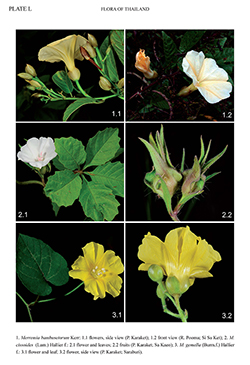e-Flora of Thailand
Volume 10 > Part 3 > Year 2010 > Page 434 > Convolvulaceae > Merremia
2. Merremia cissoides (Lam.) Hallier f.wfo-0001297455
Bot. Jahrb. Syst. 16: 552. 1893.— Convolvulus cissoides Lam., Tabl. Encycl. 1: 462. 1793.— Ipomoea cissoides (Lam.) Griseb., Fl. Brit. W. Ind. 473. 1862. Plate L: 2.
Accepted Name :
Distimake cissoides
(Lam.) A.R.Simões & Staples
Bot. J. Linn. Soc. 183: 573. 2017.
Description : Perennial herbaceous twiners; stems 1–4 m, covered with glandular trichomes mixed with large, setose hairs. Leaves palmately compound, 1.5–5 by 0.5–2 cm; leaflets usually 5, ovate oblong to lanceolate or linear-lanceolate, both ends attenuate, margins dentate or rarely entire, glandular and setose pubescent; short-petiolulate or subsessile; petiole 3–5 cm. Inflorescences axillary, cymose, 3–9-flowered; peduncle 6–10 cm; bracts linear to attenuate lanceolate, 3–15 mm; pedicel 3–10 mm. Flower: sepals subequal or outer shorter, ovate to ovate-lanceolate, subrhomboid, 10–18 mm long, long-acuminate, densely glandular or hirsute-pilose; corolla funnelform, 2–2.5 cm long, white or cream, glabrous; stamens included, unequal, 12–15 mm long, anthers spirally dehiscent; pistil included, ovary ovoid-conical. Capsules globose, 7–10 mm, glabrous, light brown. Seeds ovoid, 4–4.5 mm long, black, with small patches of short trichomes spread over surface.
Thailand : EASTERN: Ubon Ratchathani; SOUTH-EASTERN: Sa Kaeo.
Distribution : Native in tropical America (type, French Guiana), in Asia, known to be in India and Sri Lanka.
Ecology : Along roadsides in agricultural area and vacant, disturbed land, 220–600 m alt. Flowering: January, November; fruiting: January, November.
Notes: This weedy species has spread rapidly and is now common in agricultural areas; it is more widely distributed than the few herbarium vouchers would suggest.

